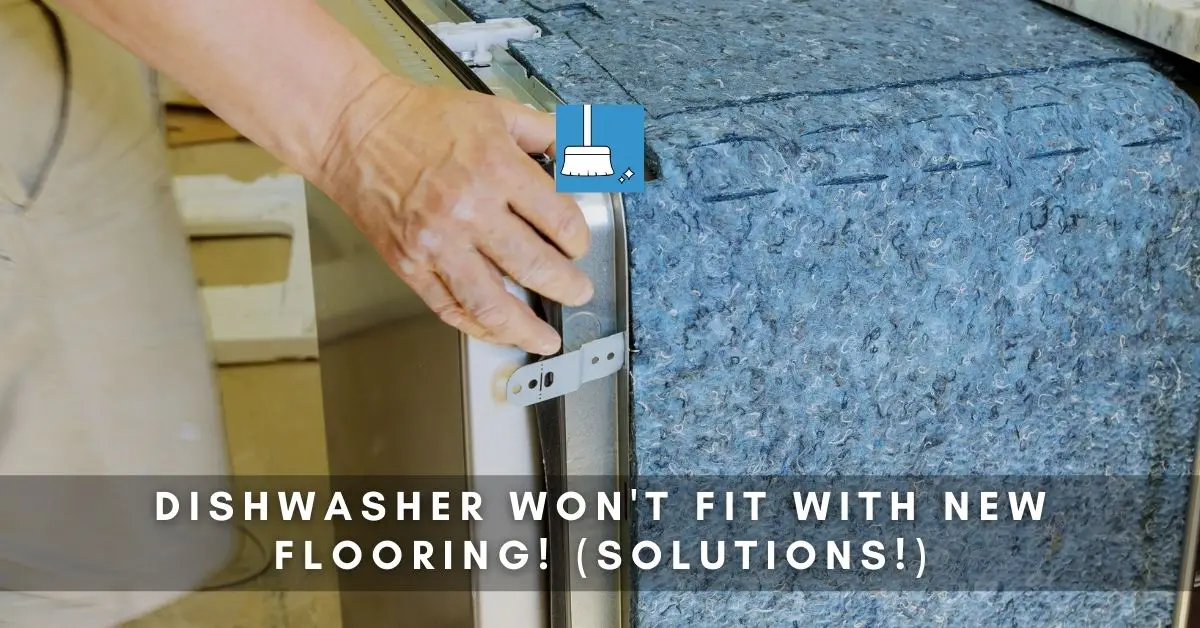You have just installed new flooring and you try to fit in your dishwasher under the counter but it no longer fits. Perhaps it goes in but you realize that the space is too loose now. This is a much more common issue than you might realize.
Sure, you can hire someone to fix it for you but if you are reading this article, you are probably considering saving your money and fixing the problem DIY style. If so, then this article has you covered.
This guide will give you important information on dishwasher installation and flooring. It will also give you the solutions you need to be able to solve dishwasher-flooring problems you may be encountering.
Dishwasher Won’t Fit with New Flooring (Solutions!)
With new flooring, it is more probable that the dishwasher space became tighter, but it could also be that the space is now too loose. We will explain the solution to both of these situations separately.
Scenario 1: Dishwasher Space Gets Tight after Installing New Flooring
If your dishwasher is not going in after installing new flooring, it is likely because your new flooring has an increased thickness compared to the former one.
It might also be that you did not previously have flooring under or around the dishwasher.
In either case, the space for the dishwasher has become more cramped and if it was an exact fit before, it will no longer go in. To resolve the issue, try the following:
1- Remove the Top Attaching Panel
If there is a wooden cross-piece attached to the countertop used to hold the dishwasher to it, removing it might fix your problem.
Depending on the material your countertop is made of, you may also be able to cut it from the underside using good quality cutting tools. You might require a professional to do this for you to avoid damaging your countertop or injuring yourself.
2- Get Rid of Dishwasher Legs or Screws
Most dishwasher leveling feet are adjustable and removable. You can reduce the feet to the minimum height to see if your dishwasher will fit in the cabinet, if not you may need to totally do away with the leveling legs of your dishwasher totally.
Ensure you consult the manual of your dishwasher to make sure that removing the legs does not void your warranty and will not cause your dishwasher to stop working or malfunction.
You may need to do away with the leveling legs of your dishwasher totally or reduce the size to its lowest height to see if it will fit.
3- Adjust the Countertop
You can try adjusting your counter to raise it just enough to cover for the added height of the new flooring.
You can then fit in your dishwasher and fix your countertop back. Be careful with doing this though because this method may damage your countertop depending on how delicate is the material that it is made of.
4- Remove the Flooring
You may need to remove the flooring under the dishwasher completely to create more room so that the dishwasher stays on the sub-floor.
If the space under your dishwasher is floored, removing the flooring may create enough space for your dishwasher to fit.
If it is not floored but the front of the dishwasher is floored which is stopping your dishwasher from fitting, you might have to remove some of the flooring immediately in front of the dishwasher.
Before you do this, be sure to find out that your flooring can be easily replaced.
5- Cutting Holes through Your Wooden Floor
This trick works for only wooden floors. You can cut holes around the dishwasher leg supports so they will drop and come forward through the opening in the flooring.
You will need to do this carefully so that you do not destroy your flooring or make it an eyesore to look at. If you cannot do it yourself, just hire someone to do it for you.
Understandably, you might not want to do this especially if your flooring costs a lot of money.
6- Buy a New Dishwasher
If none of the above suggestions work for you, you may need to purchase a newer and smaller dishwasher.
Some dishwasher brands have dishwashers that come smaller than standard sizes. They may be more expensive choices but buying them might be your only option if you have a really tight dishwasher space.
Installing a Dishwasher without Legs!
The leveling legs of your dishwasher are there so that the dishwasher stays balanced even on unlevel ground. If you want to install your dishwasher without its legs due to a space problem, you probably want to know if (and how) this can be done.
You can install a dishwasher without legs as long as your floor is level.
However, you should note that some dishwasher brands will not work if you do not install them with the leveling legs.
Steps to Adjust Dishwasher Legs
In case you need to raise or reduce the level of the legs, you can follow these steps:
STEP 1- Make use of a screwdriver to remove the kick panel of the dishwasher.
STEP 2- Make sure the leg you want to adjust is resting perfectly on the floor before starting the adjustment process.
STEP 3- Make sure the front door of the dishwasher is locked.
STEP 4- Attach a magnetic bubble level to the front of the door to make it sit vertically along one side of the dishwasher.
STEP 5- Have someone gently pull up on the front of the dishwasher to lift the bottom of the leg off the floor for easy rotation.
STEP 6- You will see a nut at the bottom of the adjustment leg. Rotate that nut counterclockwise. This will raise the level of your dishwasher.
Scenario 2- Dishwasher Space Gets Loose after Installing New Flooring
This problem usually occurs when the flooring you install is of a lower height or thickness than the previous one installed. It is an issue that is easier to address than the dishwasher space being too tight.
If your dishwasher space becomes loose, these are a couple of ways you can fix it:
1- Adjust the Legs
The first way is by simply adjusting the legs of your dishwasher so that it fills the height and is closer to your countertop.
2- Use a Top Bracket
You can also attach a piece of plywood underneath the counter and then anchor the dishwasher top to the wood with a bracket.
If your dishwasher does not have a bracket installed to fasten it to your counter, you should install one as this makes it much firmer. You can use side brackets as well.
3- Add a Plywood Layer
If there is still space to be filled after extending your dishwasher legs to the maximum height, you can add a layer of plywood or Laminate floor underneath it. This will raise it and help close the gap.
4- Use a Frame
If there are gaps on the side of the dishwasher as well, you may need to construct a wooden frame that you will attach to the inside of your cabinet space before fixing the dishwasher inside.
Should I Install New Flooring under the Dishwasher? (Pros & Cons)
This question is quite common when installing new flooring in the kitchen and there are mixed opinions about this.
While some people believe you should run your flooring under the dishwasher, others believe that you most definitely should not. You can compare the pros and cons to find out which is best for you.
Pros
1- Depending on the construction of your kitchen and cabinets, some areas under your dishwasher may be visible. It would be much better to look at it (because of the appealing aesthetics) with some nice flooring underneath it.
Cons
1- If you install raised flooring in your kitchen without running it under your appliances, your flooring becomes uneven.
This situation makes it very stressful and problematic when you try to bring out the dishwasher for maintenance, repairs, or remodeling purposes.
2- Running your flooring under the dishwasher incurs extra costs which you can avoid.
3- Installing flooring under your dishwasher can change the dimension of the space left for your dishwasher so that the space becomes too tight or too loose.
4- Installing flooring under the dishwasher usually increases the possibility of damage to the flooring; from scratching to damage from water.
How to Protect Hardwood Floors under the Dishwasher?
Hardwood flooring is a common flooring choice these days mostly due to its aesthetic appeal. However, using hardwood in the kitchen, especially under the dishwasher increases the risk of damage to your floor.
Here are some ways you can prolong the lifespan of your hardwood:
1- Clean any spills on it immediately.
2- Check frequently to make sure there is no leakage from the dishwasher. If this goes unfixed, it will eventually destroy your wooden floor.
3- Do not drag the dishwasher along the wooden floor. If you must move it, do so along a plywood surface placed on the floor.
4- Apply a sealant to your hardwood floor to renew its waterproof abilities as frequently the wood manufacturer recommends.
Oil-based ones are usually recommended for the kitchen area even though they take longer to dry.
How to Get the Dishwasher Out with a Raised Floor?
For a dishwasher trapped in by raised flooring, there are two major solutions:
1- Raising your countertop to access the dishwasher. Depending on your type of countertop, this might be fairly easy to do or extremely hard to pull off.
2- Removing some parts of the flooring in front of your dishwasher.
While none of these solutions seem appealing, they might be your only available choices if your dishwasher is trapped in the cabinet by a raised floor.
A Few Tips
1- You would need to evaluate which one of the options would be more cost-effective and less labor-intensive to go with.
Caution: Before you do any of this, be sure to take basic precautions. Turn the power and the water off and make sure you remove all the screws holding the dishwasher in place before attempting to pull it out.
2- Don’t try to pull it out with the door.
3- When you want to install new flooring in your kitchen, get experienced workers (installation workers). If you decide to do it yourself, try to get new flooring that is similar in thickness to your former one.
Final Thoughts!
Installing new flooring in the kitchen can be a bit of a hassle considering all the appliances, especially the dishwasher, which are much harder to move than the others. With this guide, you now know what to do if you find yourself in a dishwasher-flooring pickle.
In addition, you have gained some extra information about dishwasher-flooring installation and care.






Pingback: Can You Put A Dishwasher Against A Wall? (Location Rules!) »